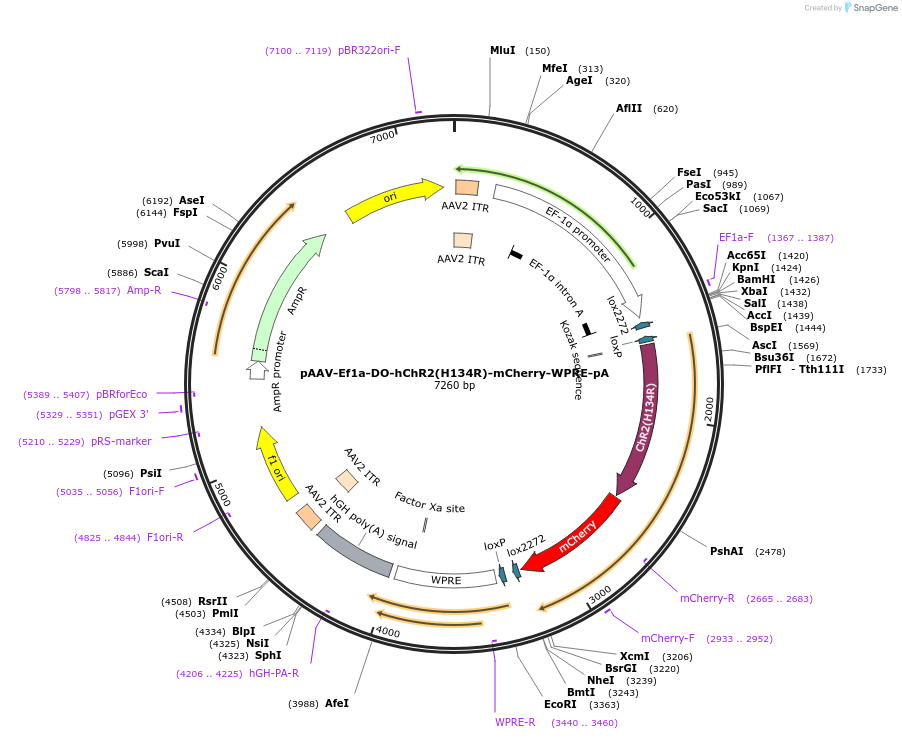-
PurposeCre-dependent expression of hChR2(H134R) for optogenetic excitation
-
Depositing Lab
-
Sequence Information
Ordering
| Item | Catalog # | Description | Quantity | Price (USD) | |
|---|---|---|---|---|---|
| Plasmid | 37082 | Standard format: Plasmid sent in bacteria as agar stab | 1 | $89 | |
Want a viral vector made from this plasmid?
Make a packaging request and we'll get back to you.
Please log in to submit a packaging request.
-
SerotypeSelect serotype for details See details about
-
PricingSelect serotype and quantity $ USD for preparation of µL virus + $32 USD for plasmid.
-
How this works
- Place a request for a quantity of 2 (0.2 mL), 10 (1 mL), 25 (2.5 mL), or 50 (5 mL). Our all-inclusive pricing includes DNA production and QC.
- Addgene will quickly confirm that we can produce a high-quality prep for you.
- Track your request and place an order from within your account. Payment information must be added before we can begin processing your order.
- Receive your prep in 6–9 weeks after the MTA is approved by your organization.
- Learn more about our Packaged on Request Service.
Backbone
-
Vector backbonepAAV-Ef1a-DIO-hChR2(H134R)-mCherry-WPRE-pA
-
Backbone manufacturerK. Deisseroth Lab
- Backbone size w/o insert (bp) 5613
- Total vector size (bp) 7260
-
Vector typeAAV, Cre/Lox ; Cre-Off
Growth in Bacteria
-
Bacterial Resistance(s)Ampicillin, 100 μg/mL
-
Growth Temperature37°C
-
Growth Strain(s)Stbl3
-
Copy numberUnknown
Gene/Insert
-
Gene/Insert namehChr2(H134R)-mCherry
-
SpeciesSynthetic
-
Insert Size (bp)1647
- Promoter EF1a
-
Tag
/ Fusion Protein
- mCherry (C terminal on insert)
Cloning Information
- Cloning method Restriction Enzyme
- 5′ cloning site Asc1 (unknown if destroyed)
- 3′ cloning site Nhe1 (unknown if destroyed)
- 5′ sequencing primer CTTCCATTTCAGGTGTCGTG
- 3′ sequencing primer GCAGCGTATCCACATAGCG
- (Common Sequencing Primers)
Resource Information
-
A portion of this plasmid was derived from a plasmid made byKarl Deisseroth Lab, Stanford Univ.
-
Articles Citing this Plasmid
Terms and Licenses
-
Academic/Nonprofit Terms
-
Industry Terms
- Not Available to Industry
Trademarks:
- Zeocin® is an InvivoGen trademark.
These plasmids were created by your colleagues. Please acknowledge the Principal Investigator, cite the article in which the plasmids were described, and include Addgene in the Materials and Methods of your future publications.
-
For your Materials & Methods section:
pAAV-Ef1a-DO-hChR2(H134R)-mCherry-WPRE-pA was a gift from Bernardo Sabatini (Addgene plasmid # 37082 ; http://n2t.net/addgene:37082 ; RRID:Addgene_37082) -
For your References section:
Recurrent network activity drives striatal synaptogenesis. Kozorovitskiy Y, Saunders A, Johnson CA, Lowell BB, Sabatini BL. Nature. 2012 May 13;485(7400):646-50. doi: 10.1038/nature11052. 10.1038/nature11052 PubMed 22660328








